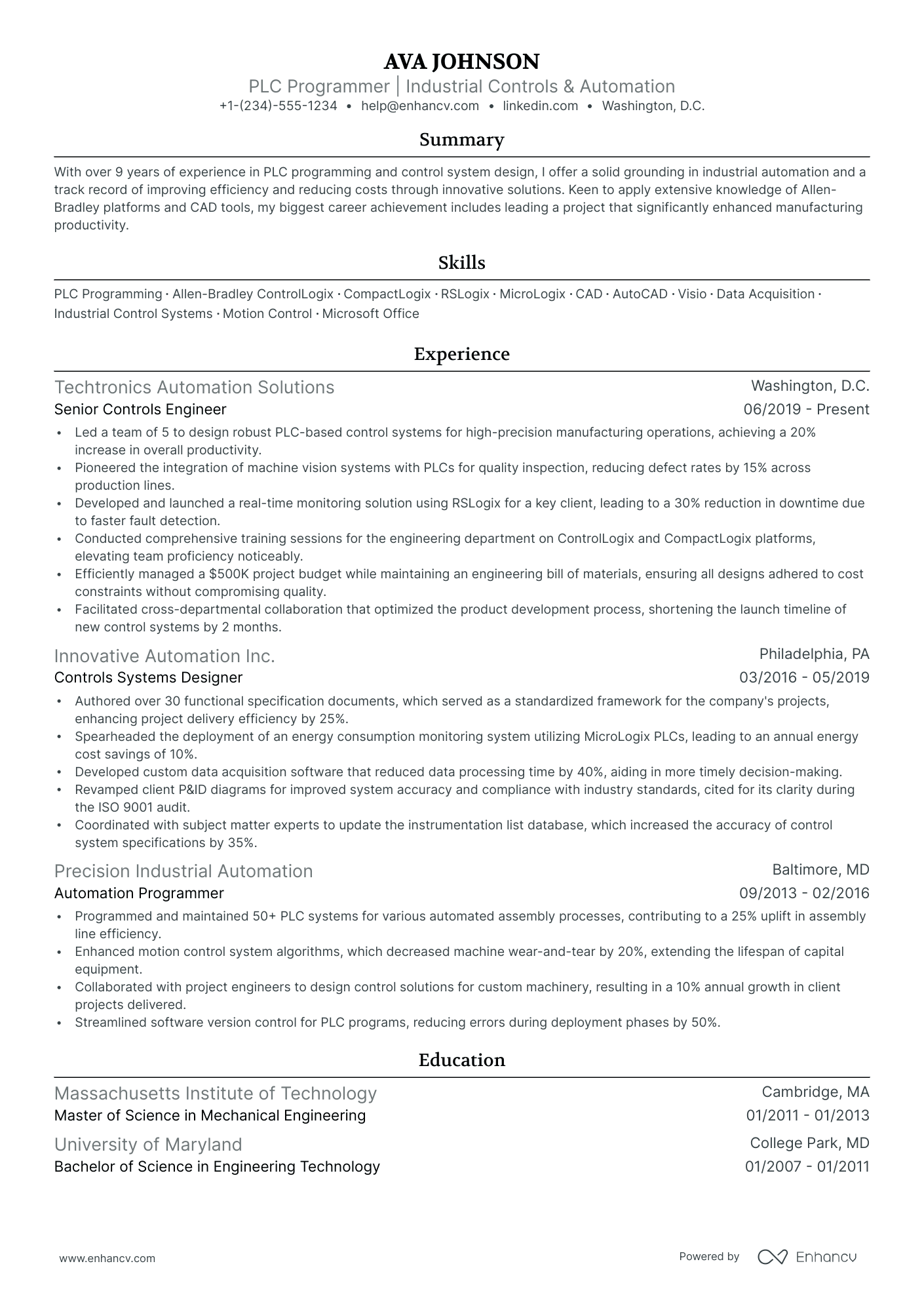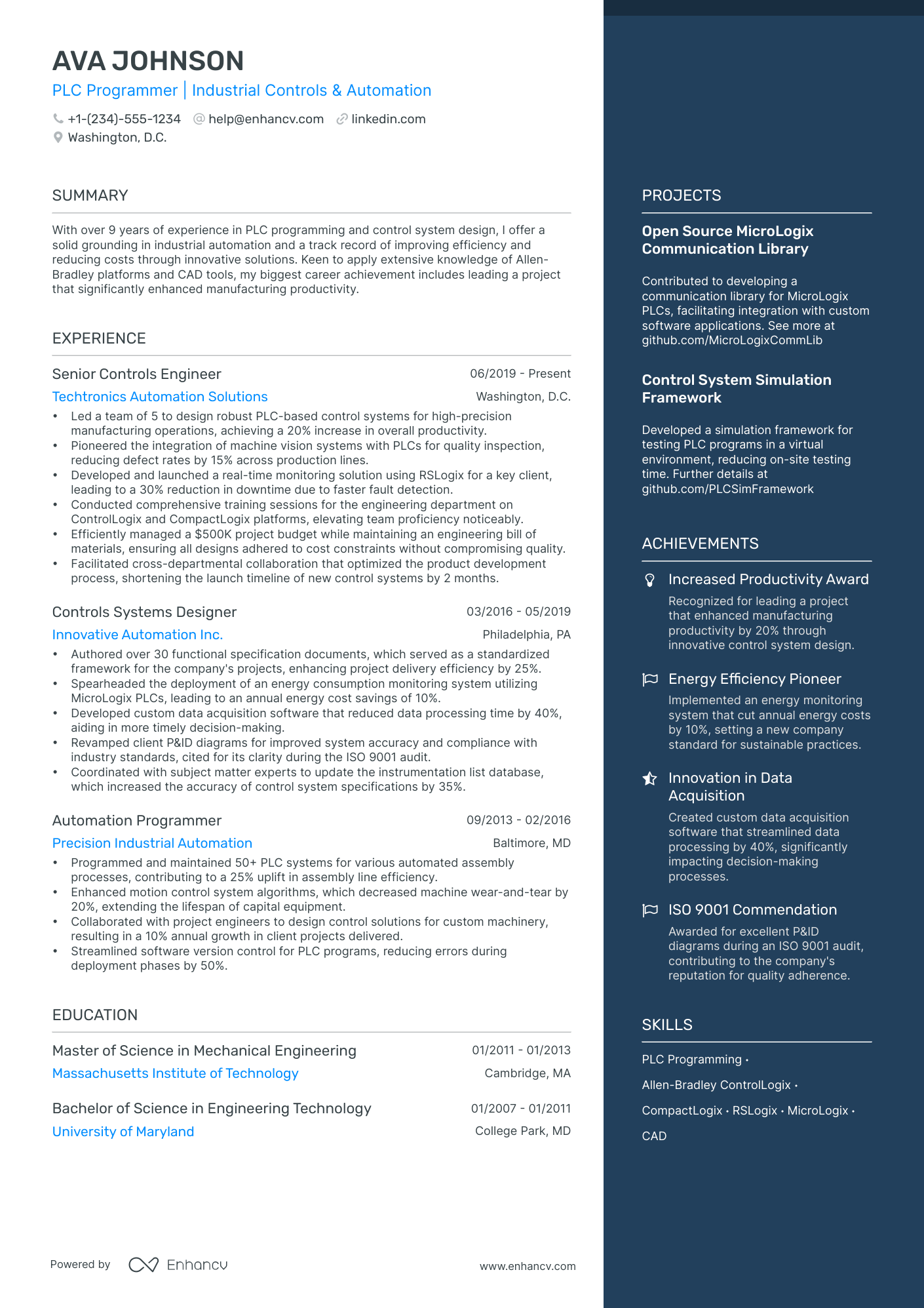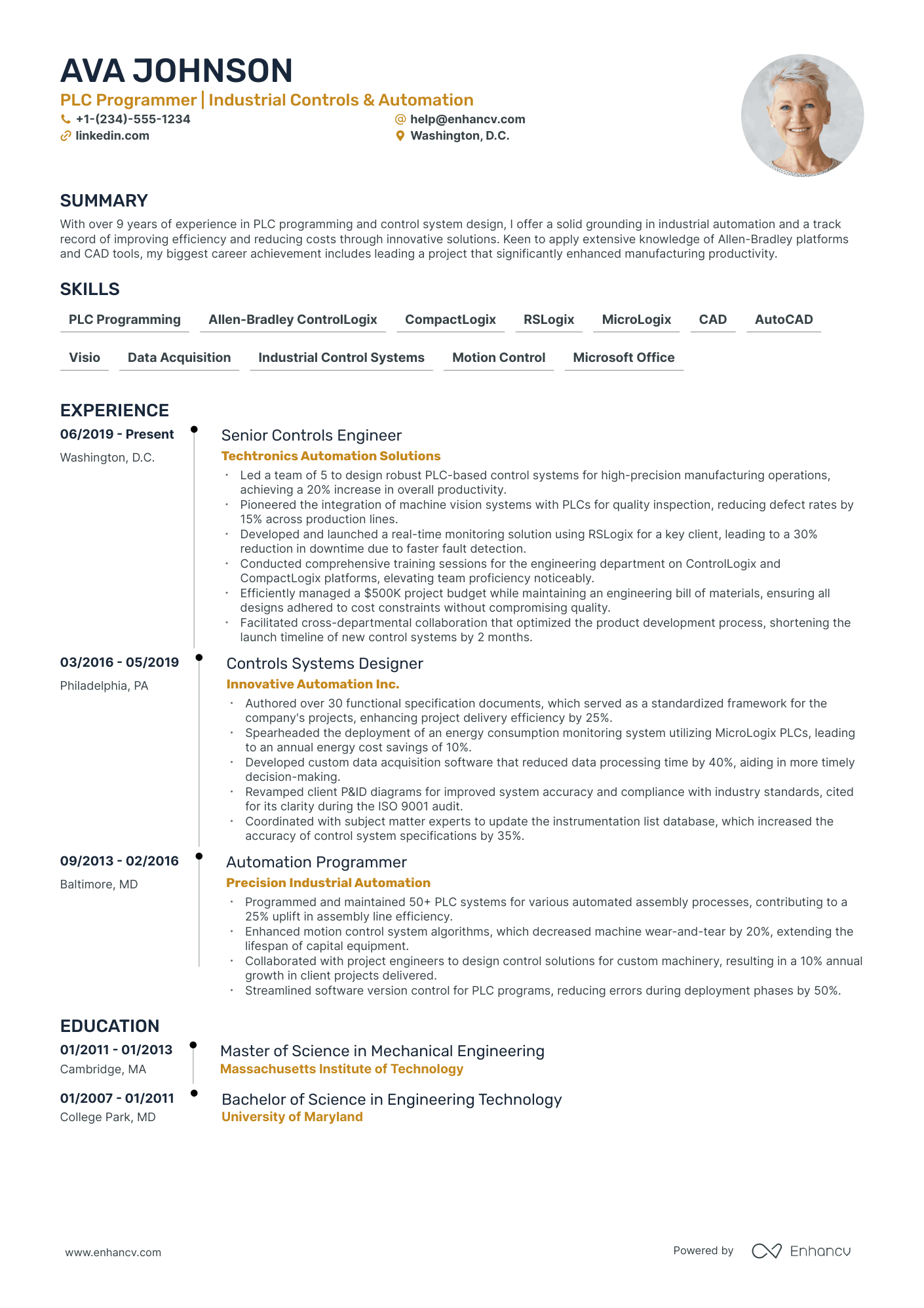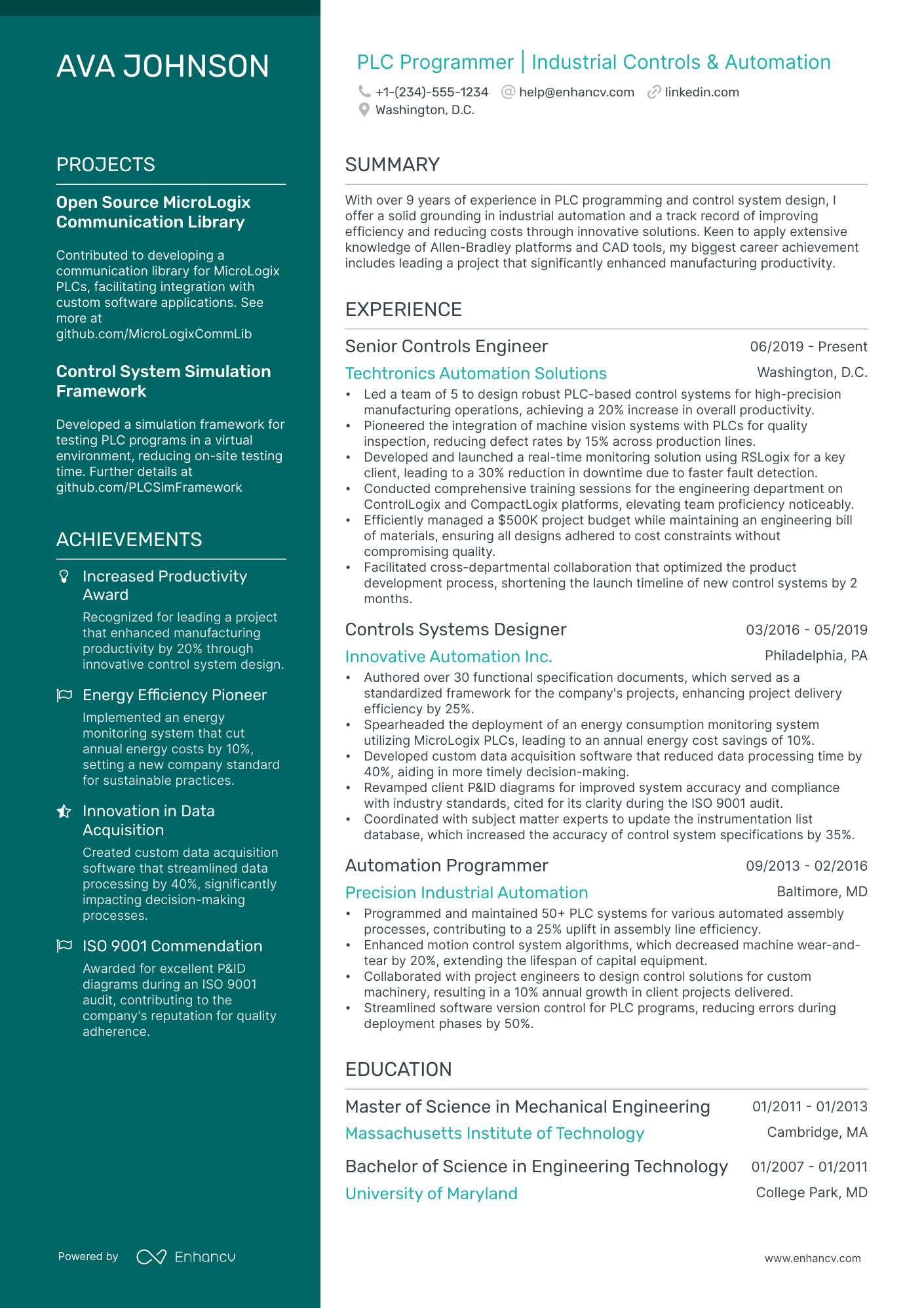As a PLC programmer, you may find it challenging to succinctly showcase your diverse range of technical skills and project experiences on your resume. Our guide offers tailored strategies and examples to help you effectively highlight your expertise and make a strong impact on potential employers.
- Which sections do you need to include in your resume to meet recruiters' requirements;
- How to write your plc programmer resume experience section - even if you have don't have little to no work experience;
- Real-life professional examples to guide you how to write the most important plc programmer resume sections;
- Adding even more sections so your plc programmer resume stands out with professionalism and your personality.
We've also selected some of the best (and most relevant) resume guides for the plc programmer role you're applying for:
- SAS Clinical Programmer Resume Example
- Java Full Stack Developer Resume Example
- Database Developer Resume Example
- System Analyst Resume Example
- IT Operations Manager Resume Example
- Service Desk Manager Resume Example
- Snowflake Developer Resume Example
- Developer Resume Example
- Technical Support Manager Resume Example
- Desktop Support Resume Example
Simple guide to your plc programmer resume format and layout
Successful plc programmer resumes all have one specific characteristic - candidates have invested in a simple resume layout . One that is easy to read, makes a good first impression, and is adapted to their professional experience. There are three distinct resume formats to help you focus on your:- professional experience - use the reverse-chronological resume format;
- skills and achievements - via the functional skill-based resume format;
- both experience and skills - with a hybrid resume format .
What is more, keep in mind that your resume may be initially assessed by the ATS (Applicant Tracker System) (or the software used by companies in the hiring process). The plc programmer resumes that suit the ATS:
- have a header that includes either a role keyword or the job you're applying for;
- should be no longer than two pages;
- be submitted as PDF, unless specified otherwise.
Upload & Check Your Resume
Drop your resume here or choose a file. PDF & DOCX only. Max 2MB file size.
PRO TIP
Showcase any ongoing or recent educational efforts to stay updated in your field.
PLC Programmer resume sections to answer recruiters' checklists:
- Header to help recruiters quickly allocate your contact details and have a glimpse over your most recent portfolio of work
- Summary or objective to provide an overview of your career highlights, dreams, and goals
- Experience to align with job requirements and showcase your measurable impact and accomplishments
- Skills section/-s to pinpoint your full breadth of expertise and talents as a candidate for the PLC Programmer role
- Education and certifications sections to potentially fill in any gaps in your experience and show your commitment to the industry
What recruiters want to see on your resume:
- Proficiency in PLC programming languages such as Ladder Logic, Function Block Diagram (FBD), Structured Text (ST), or Sequential Function Charts (SFC).
- Hands-on experience with specific PLC hardware brands and platforms like Allen-Bradley, Siemens, Modicon, or Omron.
- Knowledge of industry standards and regulations like IEC 61131-3 or ISA-88, and safety protocols such as SIL or Performance Levels.
- Familiarity with Human-Machine Interface (HMI) development and SCADA systems integration.
- Demonstrated experience with troubleshooting, diagnosing, and resolving complex control systems issues.
Quick guide to your plc programmer resume experience section
After deciding on the format of your resume, it's time to organize your experience within the dedicated section.
It's common for plc programmer professionals to be confused in this part of the process, as they may have too much or little expertise.
Follow the general rules of thumb to be successful when writing this part of your resume:
- The perfect number of bullets you should have under each experience item is no more than six;
- Select not merely your responsibilities, but the most noteworthy achievements for each role that match the job requirements;
- List any certificates or technical expertise you've gained on the job and how they've helped you progress as a professional;
- Carefully select the power verbs to go along with each bullet to avoid generic ones like "managed" and instead substitute those with the actuality of your particular responsibility;
- Integrate valuable keywords from the job advert in the form of achievements under each role you list.
If you're on the search for further advice on how to write your plc programmer experience section, get some ideas from real-world professional resumes:
- Developed and optimized machine control logic for a series of high-speed packaging lines, increasing throughput by 17% without additional capital investment.
- Spearheaded a plant-wide systems upgrade for automated processes which enhanced system reliability by 25%, consequently reducing downtime and maintenance costs.
- Implemented a new HMI strategy that improved user experience and operational efficiency, leading to a 30% reduction in operator training time.
- Collaborated on a multimillion-dollar project as a lead programmer to design the control system for wastewater treatment plants, enhancing processing capacity by 40%.
- Authored comprehensive documentation for PLC programs, which improved maintainability and facilitated a smoother handover to the in-house engineering team.
- Facilitated a series of cross-functional workshops between engineering and operations teams to align on best practices for system integrations.
- Programmed and customized PLC logic for 20+ custom-built assembly lines for the automotive industry, each enhancing production efficiency by at least 10%.
- Provided onsite support and training for operators and technicians, ensuring smoother adoption of new control systems and minimizing learning curves.
- Led a successful initiative to standardize programming procedures across projects, resulting in a consistent 15% reduction in development time per project.
- Initiated and implemented a complete overhaul of legacy control systems for a leading food and beverage company, increasing production line efficiency by 20%.
- Delivered custom PLC solutions tailored to client specifications, ensuring compatibility with existing infrastructure and seamless integration.
- Routinely conducted system diagnostics and preventive maintenance, which contributed to a 90% reduction in unscheduled downtime.
- Played a critical role in the development of an innovative conveyor sorting system that boosted sorting capacity by 25% while maintaining a 99.8% accuracy rate.
- Actively participated in client meetings to gather requirements and provide technical expertise, which facilitated the closing of contracts worth $2 million+.
- Streamlined the PLC code deployment process using version control tools, improving code quality and reducing deployment errors by over 50%.
- Designed and programmed intricate control systems for material handling equipment, leading to a 35% increase in material throughput for multiple logistics centers.
- Mentored and led a team of junior PLC programmers, contributing to a 20% overall improvement in the team's project delivery timelines.
- Resolved critical issues during system commissioning phases, which ensured projects met strict compliance and safety standards.
- Custom-built PLC programs for state-of-the-art robotic packaging lines, directly resulting in a 22% boost in operational capacity for the client.
- Completed rigorous Ladder Logic and Functional Block Diagram training for complex machinery, becoming the go-to expert for troubleshooting advanced control issues.
- Initiated proactive system monitoring protocols, significantly reducing the frequency of critical faults and improving system resilience.
- Led a cross-border team in the deployment of integrated PLC systems for an international oil and gas project, increasing the project's operational efficiency by 18%.
- Developed a sophisticated predictive maintenance system using PLC data analytics techniques, effectively reducing unplanned maintenance events by 60%.
- Optimized the use of Distributed Control Systems (DCS) in conjunction with PLCs to achieve more flexible and scalable process control solutions for large-scale plants.
Quantifying impact on your resume
- Highlight the scale of PLC systems you've programmed by specifying the number of I/O points or devices managed.
- Specify the percentage of downtime reduction achieved through your optimized PLC programs.
- Illustrate efficiency gains by quantifying the increase in production speed or output after your PLC improvements.
- Mention the amount of cost savings generated by your PLC system enhancements or energy-efficient designs.
- Document the number of PLC-related projects you've led or contributed to, demonstrating experience and leadership.
- Cite specific numbers when detailing the size of the teams you've worked with or supervised on PLC tasks.
- Quantify the number of PLC programming languages you are proficient in to show versatility.
- List the number of training sessions or workshops you've conducted to underline your expertise and contribution to staff development.
Action verbs for your plc programmer resume
PLC Programmer resume without experience: a walk-through guide
If you don't happen to have any relevant experience yet, you can substitute this with:
- Short-term gigs and stunts - like month-long internships, that you have done during your university days
- Contract work - be specific about the relevance and outcomes of each role you include
- Resume format that prioritizes your skills - the functional-skill-based format or hybrid format could work
- Research roles - feature those especially prominently if you've participated in a noteworthy project or your role was of utmost importance to the project's success.
Recommended reads:
PRO TIP
If the certificate you've obtained is especially vital for the industry or company, include it as part of your name within the resume headline.
Popular plc programmer hard skills and soft skills for your resume
Apart from assessing your professional expertise, recruiters are on the lookout for whether your skills align with the job.
Your profile would thus be assessed in regard to your:
- Hard or technical skills - your ability to perform on the job using particular technologies or software
- Soft skills - how you adapt, communicate, and thrive in different environments.
Both types of skills - hard and soft skills - are important for your resume, so make sure to create a dedicated skills section that:
- Lists up to five or six skills that align with the job advert.
- Integrates vital keywords for the industry, but also reflects on your personal strengths.
- Builds up further your skills with an achievements section within which you explain what you've achieved thanks to using the particular skill.
- Aims to always quantify in some way how you've used the skill, as it's not enough to just list it.
What are the most sought out hard and soft skills for plc programmer roles?
Check out the industry's top choices with our two dedicated lists below:
Top skills for your plc programmer resume:
Ladder Logic Programming
Structured Text Programming
Functional Block Diagram Development
Human Machine Interface (HMI) Design
Control Systems Design
Electrical Schematic Understanding
PLC Hardware Configuration
Troubleshooting and Debugging
Knowledge of Industry Standards (IEC 61131-3, etc.)
SCADA System Integration
Analytical Thinking
Problem-Solving
Attention to Detail
Time Management
Communication
Teamwork
Adaptability
Continuous Learning
Project Management
Documentation Skills
PRO TIP
List your educational qualifications and certifications in reverse chronological order.
The plc programmer resume sections you may underestimate: certifications and education
Your education and certifications provide insight into both your technical capabilities and personal attributes, such as perseverance. When crafting your plc programmer resume, consider how you present these elements:
- For your higher education degrees, prioritize listing those most relevant to the job or indicative of your academic dedication;
- Include applicable coursework as a stand-in for relevant experience or if it might impress recruiters;
- Include incomplete higher education only if it's pertinent to meeting job requirements;
- If your degree is from a renowned university, mention how often you made the Dean's list to underline academic excellence.
Regarding certifications, it's not necessary to list all of them. Instead, match up to three of your most recent or significant certificates with the technical skills required in the job description.
Below, we've selected some of the top industry certifications that could be vital additions to your plc programmer resume.
The top 5 certifications for your plc programmer resume:
- Programmable Logic Controller (PLC) Technician Certificate - PLC Technician - George Brown College
- Siemens Certified Programmer - SCP - Siemens
- Allen-Bradley Programmable Logic Controller (PLC) Certificate - Rockwell Automation
- Certified Control Systems Technician (CCST) - ISA - International Society of Automation
- Professional Engineer (PE) in Control Systems Engineering - NCEES - National Council of Examiners for Engineering and Surveying
PRO TIP
If you're in the process of obtaining your certificate or degree, list the expected date you're supposed to graduate or be certified.
Recommended reads:
PLC Programmer resume summaries or objectives: real-world samples for best industry practices
Grasp recruiters' attention from the get-go of your application with a professional PLC Programmer resume summary or objective.
It's wise to select the:
- Resume objective , if you don't happen to have much experience alignment and would like to more prominently feature your dreams and personality.
- Resume summary , if you'd like to have a more standard approach to your application and feature up to five career highlights to help you stand out.
Writing your resume summary or objective should be tailored to each role you apply for.
Think about what would impress the recruiters and go from there.
But, if you need further help with this introductory section, check out some real-world samples in the next part of this guide:
Resume summaries for a plc programmer job
- Seasoned PLC Programmer with over 8 years of robust experience in automation system design and implementation, specializing in Allen-Bradley and Siemens controllers. Proven record of reducing system downtimes by 30% through innovative programming solutions for a leading manufacturing firm in Detroit, Michigan.
- Dedicated Electrical Engineer with a focus on automation, seeking to transfer 6 years of circuit design expertise into a PLC Programming career. Solid foundation in control systems and programming logic, coupled with a Master’s degree in Electrical Engineering from MIT.
- Meticulous professional with 5 years in software development, aiming to leverage extensive background in coding and debugging to excel in PLC programming. Proactively seeking a new direction, confidently bringing proficiency in languages such as Python and C++ to the dynamic world of industrial automation.
- With 10 years in the field of industrial robotics, keen to redirect focus towards PLC programming. Adept at designing intricate systems, and instrumental in the deployment of a robotic assembly line that enhanced productivity by 25% for a European car manufacturer.
- Highly motivated graduate with a Bachelor’s in Control Engineering, eager to embark on a career in PLC programming. In-depth understanding of automation principles and hands-on training experience with miniature prototype conveyor systems during university projects.
- Ambitious individual with a passion for technology and automation, ready to apply a solid foundation in computer science principles to a challenging PLC programming career. Quick learner with a collaborative spirit, looking to contribute fresh perspective and strong problem-solving skills.
Recruiters' favorite additional plc programmer resume sections
When writing your plc programmer resume, you may be thinking to yourself, " Is there anything more I can add on to stand out? ".
Include any of the below four sections you deem relevant, to ensure your plc programmer resume further builds up your professional and personal profile:
Key takeaways
- Impactful plc programmer resumes have an easy-to-read format that tells your career narrative with highlights;
- Select a resume summary or objective, depending on what sort of impression you'd like to leave and if your accomplishments are relevant to the job;
- If you don't happen to have much industry expertise, curate additional gigs you've had, like contracts and internships, to answer how your experience aligns with the plc programmer job;
- Be specific about the hard and soft skills you list on your resume to define your niche expertise and outcomes of using those particular skills;
- Always tailor your resume for each plc programmer application to ensure you meet all job requirements.





